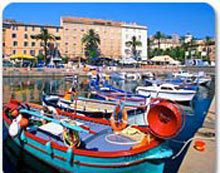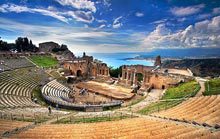 With a unique combination of pleasant climate, beautiful coastline, rich history and diverse culture, the Mediterranean region is the most popular tourist destination in the world — attracting approximately one-third of the world’s international tourists.
With a unique combination of pleasant climate, beautiful coastline, rich history and diverse culture, the Mediterranean region is the most popular tourist destination in the world — attracting approximately one-third of the world’s international tourists.
Covering more than 900,000 square miles, the Mediterranean Sea is a sea of the Atlantic Ocean. It is unique because it is almost completely surrounded by land, including Europe to the North, Africa to the South, and Asia to the East. It is connected to the Atlantic by the Strait of Gibraltar, which is just nine miles wide.
In total the Mediterranean Sea borders 21 different nations, as well as several different territories and smaller seas, and is home to over 3,000 islands. Here’s a tapas look at just a few of those islands.
CORSICA
Corsica is almost the perfect destination, basking in the Mediterranean sun off the south of France. The hundreds of beaches and nearly 625 miles of coastline form the basis of many activities on the island, with swimming, snorkelling, wind-surfing, scuba diving and sunbathing being the most popular.
Corsica is as much an island of small villages, groups of hamlets and small ports as it is of important towns. The most popular resorts and larger towns that attract most visitors include Ajaccio (Napolean’s birthplace), Bonifacio, Calvi, Porto, and Sant-Florent . Among the most popular “groups” of villages are those inland from Calvi and the hill villages of Castagniccia towards the east, but many other areas of the island also feature notable villages and clusters of hamlets.
The scenery in Corsica is diverse – from the clear blue sea and the palm tree-backed beaches to the mountains of the interior to the hill villages of the east – and there are dramatic views across the Mediterranean from many vantage points all over the island.
BALEARIC ISLANDS: Mallorca, Menorca, Ibiza, Formentera & Cabrera
With some 300 days of sunshine per year, wonderful beaches, a rich culture and the unusual hospitality of their inhabitants, the Balearic Islands are one of the preferred destinations in Spain. History and modernity melt together with the deep blue of Mediterranean Sea.
Mallorca (or Majorca) has just about everything you could want from a vacation destination. Leisure activities, including scuba diving, snorkeling, sailing and other water sports, as well as golf, horseback riding, go carting, hiking and cycling among others, are numerous and can be enjoyed all around the island. The capital of the island and the Balearics, Palma, is a vibrant city packed with culture, history, fine restaurants, trendy cafés, a buzzing nightlife and tons of ambience. The mountains on the island offer a totally different vacation experience. The Sierra de Tramuntana is a walker’s paradise, its mountain trails overlooking the rugged, craggy coast.
Menorca’s personality is very different from the rest of the islands. Though it enjoys a burgeoning tourist industry, the “jewel of the Balearics” has retained much of its virgin landscape and traditional Spanish heritage and is more suited to a laid back, nature-loving crowd or family groups. Menorca encompasses some of the most important environmental areas in the Balearic region; there are countless archaeological sites and cultural attractions ranging from prehistoric settlements and burial constructions to magnificent examples of medieval architecture and comprehensive, fascinating museums scattered about the island.
Ibiza, often called the White Island for its typical architecture, became a major center of tourism during the 1960s, being then famous for its “Hippie Culture” and nudist beaches. Today Ibiza welcomes families and older visitors but the younger crowd is still attracted by the island’s boisterous nightlife, which starts in the afternoon at the beaches and in the center of town and continues until dawn in the numerous clubs.
Formentera, the smallest of this group of islands, is best known as the “last paradise in the Med” due to lack of urban development and the limit on the number of resorts that can be built there. Formentera’s main attraction is its untouched and often deserted beaches that attract visitors seeking peace and tranquility. Cabrera is almost uninhabited, and is the site of a national park. Only day trips are allowed.

SICILY
The fascinating thing about Sicily is that it’s not really one place but many. Long a crossroads of Mediterranean culture, its diversity is striking. The island has been a melting pot of every great civilization on the Mediterranean: Greek and Roman; then Arab and Norman; and finally French, Spanish, and Italian. Phoenician settlements, Punic cities, Roman amphitheaters, Greek temples, Norman castles and Aragonese churches are all in evidence on Sicily.
Because of this diversity, there are many ways to experience Sicily. There are wine tours (near Marsala); motorcycle adventures; country retreats (guest farms) where you can stay on a working farm or rural estate (Italians call it agriturismo); themed getaways (such as Godfather tours) or family history tours (if your family has Sicilian ancestry); 4-wheeling excursions along the summit of Mt Etna; sailing along the Ionian coast; hiking; cycling; horse riding; golf; cooking classes; staying in a villa; castles, volcanoes; theme parks for the kids; and more!
With over 3,000 islands to choose from, there’s a smorgasbord of island life awaiting you in the Mediterranean!






